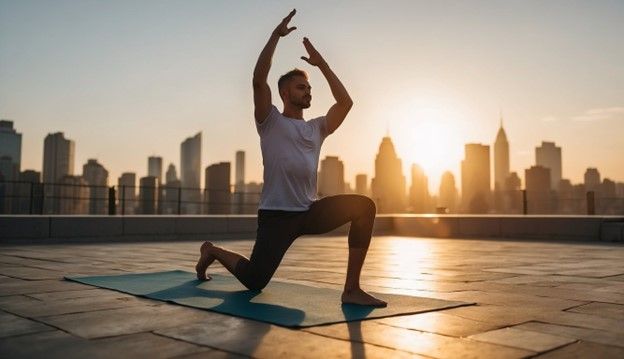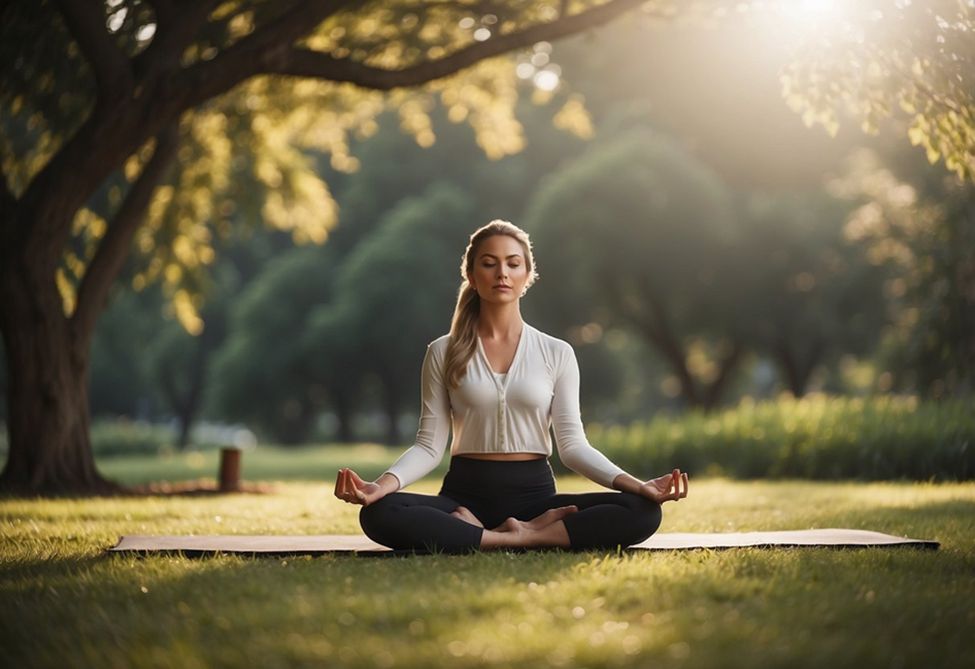1) Improved Flexibility
Yoga is well-known for its ability to enhance flexibility. Regular practice can help loosen tight muscles and increase joint range of motion.
Many yoga poses involve gentle stretching that targets different parts of the body. These poses can help lengthen muscles that may have shortened due to inactivity or repetitive motions.
Improved flexibility is often one of the first benefits people notice when practicing yoga. Over time, practitioners may find they can reach further and bend more easily.

Increased flexibility can lead to better posture and reduced aches and pains. Tight muscles can cause misalignment in the body, but yoga helps create balance and ease of movement.
It’s important to remember that flexibility varies from person to person. Yoga isn’t about touching your toes or doing extreme backbends. The goal is to improve your range of motion safely and gradually.
With consistent practice, most people will notice improvements in their flexibility. This can make everyday activities easier and more comfortable.
2) Increased Strength

Yoga can make you stronger. It uses your body weight to build muscle, and many yoga poses work multiple muscle groups at once.
Holding poses like plank or downward dog builds arm and shoulder strength. Warrior poses strengthen the legs and core muscles. Tree pose improves balance and works leg muscles.
Regular yoga practice can moderately improve muscle strength. This happens as you support your body in new ways during poses.
Yoga isn’t just about flexibility. It can be a full-body workout. Different types of yoga offer various levels of strength training.
Yoga helps build muscle strength. According to Healthline, yoga poses are designed to strengthen various muscle groups, contributing to better physical stability and endurance.
Power yoga and Ashtanga yoga are more intense. They build strength faster than gentler forms. But even mild yoga can increase strength over time.
As you get stronger, you can try harder poses. This keeps challenging your muscles. Yoga also helps prevent muscle loss as you age.
Building strength through yoga has extra perks. It improves posture and reduces the risk of injury in daily life. Plus, it’s gentle on joints compared to some other exercises.
3) Better Posture
Yoga can help improve posture by strengthening core muscles and increasing body awareness. Regular practice teaches people to stand taller and sit straighter.
Many yoga poses focus on alignment and balance. These help correct common posture problems, such as rounded shoulders or a forward-tilting pelvis.
Warrior poses are great for posture. They strengthen the legs and back while opening the chest and shoulders.
Yoga also increases flexibility in tight muscles that can pull the body out of alignment. Stretching the hip flexors and chest muscles can help counteract the effects of prolonged sitting.

Yoga breathing exercises improve core strength. A strong core supports the spine and helps maintain good posture throughout the day.
Increased body awareness from yoga helps people notice and correct poor posture habits. They become more mindful of how they hold themselves.
Simple poses like Mountain Pose teach proper standing alignment. This carries over into daily life, helping people stand and walk with better posture.
4) Enhanced Breathing
Yoga improves breathing in many ways. It teaches people to take deeper, slower breaths, which can increase lung capacity over time.
Full yogic breathing is a key technique in yoga. It involves breathing into different parts of the lungs. This helps the lungs’ capacity.
Regular yoga practice can make breathing more efficient. People may find they can take in more air with each breath, leading to better oxygen flow throughout the body.
Yoga also trains people to be more aware of their breath. This awareness can help reduce stress and anxiety and improve focus and mental clarity.
Some yoga breathing exercises can strengthen the lungs, which can be helpful for people with breathing problems and may also boost overall lung health.
Better breathing can have many positive effects. It can increase energy levels and improve sleep quality. It also helps the body get rid of toxins more effectively.
5) Reduction in Stress Levels
Yoga is a powerful tool for managing stress. It combines several techniques that help calm the mind and relax the body.
Breathing exercises, stretching, and meditation are all part of yoga practice. These elements work together to reduce stress levels.
When people do yoga, their bodies release less cortisol, a hormone linked to stress. Lower cortisol levels can help people feel more relaxed.
Yoga also helps stretch tight muscles. Stress often causes muscle tension, especially in the shoulders and hips. Stretching these areas can relieve physical discomfort related to stress.
Regular yoga practice can change how people respond to stressful situations. It teaches them to stay calm and breathe deeply when faced with challenges.
Recent studies show that yoga can reduce symptoms of anxiety and depression. This makes it a helpful tool for improving overall mental health.
6) Boosted Immunity
Yoga can boost your immune system. Regular practice helps reduce stress, which is key to strengthening your body’s defenses.
When you do yoga, your body releases fewer stress hormones, which allows your immune cells to work better to protect you from illness.
Deep breathing during yoga increases oxygen in your blood. This helps your immune cells function more effectively.
Many yoga poses gently massage your internal organs. This can improve circulation and help remove toxins from your body.
Yoga also promotes better sleep. Getting enough rest is crucial for a healthy immune system.
Some poses, like twists and inversions, may help stimulate your lymphatic system, which is crucial in fighting infections.
Regular yoga practice can help balance your hormones. Balanced hormones support overall health, including your immunity.
By making yoga part of your routine, you’re giving your body extra tools to stay healthy. Even a short daily practice can boost your natural defenses.
7) Improved Heart Health
Yoga can be great for your heart. It helps lower stress, which is good for heart health. When you’re less stressed, your blood pressure may go down.
Many yoga poses get your heart pumping. This can make your heart stronger over time. A stronger heart works better and doesn’t have to work as hard.
Yoga may help lower cholesterol and triglyceride levels. These fats in your blood can cause heart problems if they are too high.
Some yoga styles are like light workouts. They can help you maintain a healthy weight, which is important for heart health.
Yoga teaches deep breathing. This can help your body relax and may improve blood flow. Better blood flow is good for your heart and whole body.
People who do yoga often make healthier choices. They might eat better or quit smoking. These changes can help the heart.
Understanding the Basics of Yoga
Yoga is an ancient practice that combines physical postures, breathing techniques, and meditation. It offers numerous benefits for both body and mind.
History and Origins
Yoga started in India over 5,000 years ago. Ancient sages developed it to connect the body, mind, and spirit. The word “yoga” comes from Sanskrit and means “to unite” or “to join.”
Yoga spread from India to other parts of Asia over time. It came to the West in the late 1800s and early 1900s. Yoga became popular in the United States in the 1960s and 1970s.
Today, millions of people around the world practice yoga. There are many different styles, from gentle to intense.
Fundamental Principles
Yoga has several key principles:
- Breathing: Controlled breathing helps calm the mind and body.
- Postures: Physical poses build strength and flexibility.
- Meditation: Focusing the mind reduces stress and anxiety.
Yoga teaches mindfulness and body awareness. It encourages people to listen to their bodies and move with care.
Regular practice can improve balance, posture, and core strength. Yoga also promotes relaxation and better sleep.
Many people find that yoga helps reduce pain from conditions like arthritis and back problems.
Frequently Asked Questions
What are the key physical improvements one can expect from practicing yoga regularly?
Regular yoga practice can lead to better flexibility, increased strength, and improved posture. These changes can help reduce back pain and improve balance.
Yoga also enhances breathing capacity and reduces stress levels. This can result in better sleep and increased energy throughout the day.
How does yoga contribute to muscle strength and tone?
Yoga uses body weight to build muscle strength. Holding poses for longer periods helps tone muscles and improve endurance.
Different yoga styles target various muscle groups. For example, power yoga focuses on building upper body strength, while vinyasa flow works on full-body toning.
Can yoga enhance cardiovascular health, and if so, how?
Yes, yoga can boost heart health. More active styles of yoga, like vinyasa or power yoga, can increase heart rate and improve cardiovascular fitness.
Even gentler forms of yoga can lower blood pressure and reduce stress. This helps protect the heart and improve overall cardiovascular health.
In what ways does yoga impact flexibility and joint health?
Yoga poses gently stretch muscles and connective tissues. This increases flexibility over time and improves joint range of motion.
Regular practice can also help reduce joint pain and stiffness. This is especially beneficial for people with arthritis or other joint conditions.
What role does yoga play in weight management and metabolism?
While not a high-calorie burner, yoga can support weight management. It builds lean muscle mass, which can boost metabolism.
Yoga also reduces stress, which can help prevent stress-related eating. Some styles of yoga, like power yoga, can be more effective for weight loss.
How does regular yoga practice benefit women’s health specifically?
Yoga can help ease menstrual discomfort and reduce symptoms of menopause. It may also improve fertility by reducing stress and balancing hormones.
For pregnant women, prenatal yoga can help prepare the body for childbirth and reduce pregnancy-related back pain.

